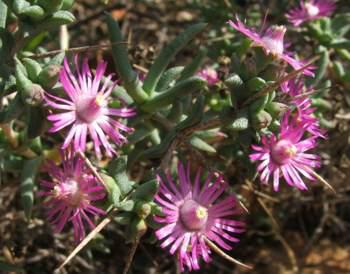Ruschia spinosa
Ruschia spinosa (L.) Dehn. (= Eberlanzia spinosa (L.) Schwantes)
Family: Aizoaceae
Common names: thorny vygie, spiny ruschia (Eng.); doringvygie (Afr.)
Introduction
If one is looking for a striking waterwise plant for a Karoo garden or a desert garden, look no further than this spinescent succulent shrub with beautiful purple flowers!

Description
Description
Ruschia spinosa is a spinescent shrub, 350-700 mm high with a rounded habit. Whitish grey internodes turn black with age. Flowers are scented, with striking purple petals, arranged in spiny cymes, a flower cluster in which all floral stems end with a flower and central flowers opening first. It flowers profusely in spring and early summer, from September to December. The fruit is a five-lobed capsule, with or without narrow valve wings. Seeds are very small. Ruschia spinosa takes about two years to be fully grown.

Conservation Status
Status
Ruschia spinosa is not a threatened plant.
Distribution and habitat
Distribution description
Ruschia spinosa can be found in the Northern Cape, Eastern Cape, and Western Cape and Namibia, occurring in the Succulent- and Nama-Karoo Biomes.
Derivation of name and historical aspects
History
The genus Ruschia is named in honour of the late Mr Ernst Julius Rusch (1867 - 1957), originally from Germany, who settled on the farm Lichtenstein, near Windhoek in Namibia. He was one of the founders of Windhoek. Ruschia has a very wide distribution with 224 species. The specific name spinosa, is derived from the Latin word for spine, Ruschia spinosa being a spinescent shrub.
Ruschia spinosa, was brought to Kirstenbosch in July 1914 by James Dugal Cameron Lamb, a keen plant collector. He started a herbarium, Herbarium Lambii, and donated his plant collection of more than 1000 specimens, to the South African Museum Herbarium shortly before his death in 1937.
Ecology
Ecology
The very small seeds are dispersed by raindrops as the capsule valves open in wet conditions.

Uses
Use
Ruschia spinosa is eaten by small stock and springbuck, depending on the growing conditions. It is a waterwise plant, suitable for Karoo and Namib Desert gardens.
Growing Ruschia spinosa
Grow
Crush capsules to release seeds. Sow seeds from March to August. Use two parts sand, one part loam and one part compost and not wood, straw or stone as mulch. Cover seeds with a thin layer of sand. Place in partial shade and keep moist until germination occurs. Always water with a fine spray. Always harden plants off before planting out
References
- Codd, L.E.& Gunn, M. 1981. Botanical Exploration of southern Africa. Botanical Research Institute, Pretoria.
- Codd, L.E.& Gunn, M. 1984. J.D.C. Lamb and the `Herbarium Lambii'. Veld and Flora. 70,2:61,62.
- Leistner, O.A. (ed.). 2000. Seeds plants of southern Africa: families and genera. Strelitzia 10. National Botanical Institute, Pretoria.
- Renu-Karoo unpublished data. www.renu-karoo.co.za ruschia. Accessed 4 July 2014.
- Snijman, D.A. (ed). 2013. Plants of the Greater Cape Floristic Region, Vol. 2: the Extra Cape flora. Strelitzia 30. South African National Biodiversity Institute, Pretoria
- Van Jaarsveld, E.J. 2010. Waterwise gardening. Struik, Cape Town.
Credits
Hannelie Snyman
Kirstenbosch National Botanical Garden
August 2014
Plant Attributes:
Plant Type: Shrub, Succulent
SA Distribution: Eastern Cape, Northern Cape, Western Cape
Soil type: Sandy
Flowering season: Spring
PH: Acid, Neutral
Flower colour: Purple, Pink
Aspect: Full Sun
Gardening skill: Average
Special Features:
Horticultural zones








Rate this article
Article well written and informative
Rate this plant
Is this an interesting plant?
Login to add your Comment
Back to topNot registered yet? Click here to register.